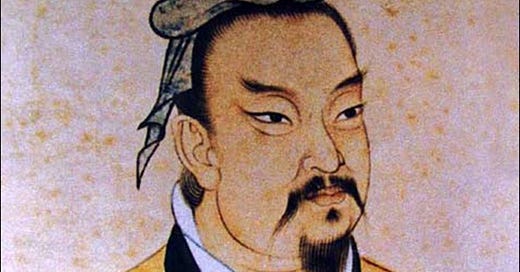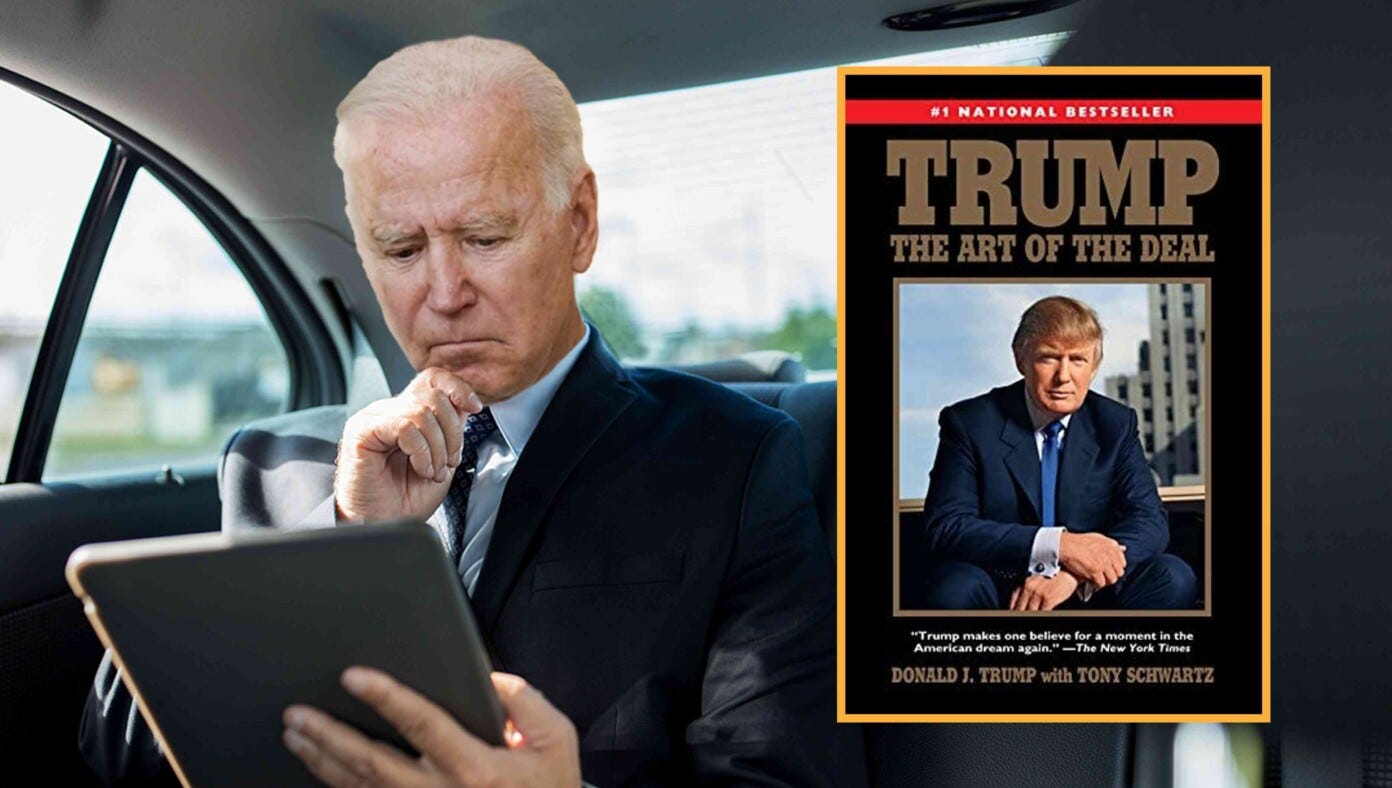The Yangtze, the Chip, and the Tariff Gambit – Letter #12
“Pretend inferiority and encourage his arrogance.” – Sun Tzu
I realise I’ve spent the last two weeks lamenting Europe’s woes, so this week it felt only right to turn our attention to China—a country that has perfected the art of keeping the world guessing. . . .
My first encounter with Chinese [fake] history came in my youth through an unlikely medium: the movie Crouching Tiger, Hidden Dragon. It’s probably as absurd as it is irreverent, looking back, that my introduction to such a storied heritage came through a martial arts blockbuster. But I was captivated. The film’s elegance, its sweeping landscapes, and its focus on skill over brute force left a lasting impression.
A few years later, my brother handed me The Art of War by Sun Tzu. Its core ideas struck a chord: knowing when to act, when to wait and how to turn weakness into an advantage. This was a masterclass in conflict, competition, and adversity. Not bad for someone whose fiercest battles at the time were fought over extra screen time for Heroes of Might and Magic IV.
One famous Chinese tale still taught to children today brings these themes to life: the Battle of Red Cliffs. It tells the story of Cao Cao, the Prime Minister of the Han dynasty, who in 208 AD led an army of 800,000 soldiers to crush an alliance between two rival warlords, Sun Quan and Liu Bei, whose combined forces numbered just 50,000. Cao Cao’s campaign aimed to expand his control over the southern territories by sea, while Sun Quan and Liu Bei, despite their differences, united to resist him.
By every measure, Cao Cao’s army should have triumphed. But Sun Quan and Liu Bei didn’t fight strength with strength—they fought with strategy. They lured Cao Cao into a critical mistake, sending a trusted defector to convince him to chain his fleet together for stability against the Yangtze River’s currents. Certain of his superiority, Cao Cao followed the advice. It was a fatal decision. When the winds shifted, fireboats were sent into his fleet, turning the Yangtze into a sea of flames. By dawn, Cao Cao’s navy had been reduced to ashes and his ambitions lay in ruin.
The story of Red Cliff is a vivid reminder that overconfidence can be a fatal flaw. It shows how the greatest risks often arise from overestimating one’s own strength and underestimating an opponent’s capabilities. This ancient lesson resonates today as China demonstrates its ability to turn perceived disadvantages into strengths, particularly in technology.
As we’ve seen this week, China has a way of catching people off guard. We’ve received several signs that, while much of the world remains fixated on American exceptionalism, China’s technological prowess is not only alive and well but also rapidly accelerating.
Let’s dive in.
Catalysts for Reflection
Last Tuesday, Huawei released its Mate 70 Pro, a device that has swiftly upended assumptions about the state of Chinese innovation and US tech dominance. Huawei’s Mate 70 Pro, powered by HarmonyOS Next—a fully homegrown operating system independent of Google’s Android—and a domestically produced chip fabricated by SMIC, signals a pivotal moment in China’s technological self-reliance. This chip, manufactured without reliance on Taiwan’s TSMC, showcases capabilities many believed were years away for China, including near-5G performance.
Despite U.S. export controls targeting equipment from companies like ASML, these external pressures appear to have ironically catalysed China’s progress. Huawei’s achievement highlights a rapidly maturing domestic tech ecosystem, challenging the long-held assumption that U.S. sanctions could indefinitely stall China’s advancement. With the Mate 70 Pro, China has made a bold statement: it is no longer dependent on foreign supply chains to compete at the highest levels of innovation.
China’s push for technological self-reliance also extends beyond hardware, with notable strides being made in artificial intelligence. Earlier this month, Alibaba’s Qwen unveiled QwQ, a compact reasoning model that rivals larger counterparts in capability. At just 32 billion parameters—one-fifth the size of OpenAI’s GPT-3—QwQ competes on coding and mathematics benchmarks while outperforming several non-reasoning models like GPT-4 and Claude 3.5 Sonnet. This achievement demonstrates how smaller, more efficient models can be scaled effectively during inference, challenging the prevailing assumption that size always correlates with capability. The gap between Chinese and American AI capabilities may no longer be as wide as many in the West assume…
Crucially, these advancements rest on systemic investments in education and human capital. With 35% of Chinese graduates specialising in STEM fields—compared to less than 10% in the U.S.—China has built a pipeline of talent poised to dominate industries requiring advanced technical expertise, like AI, semiconductors, and renewable energy. This technical expertise, paired with a relentless work ethic, gives China a formidable competitive edge.
American Decoupling
The progress represented by the Mate 70 Pro, QwQ and other recent breakthroughs—such as China’s recent launch of ‘self-driving’ radar satellites and reaching the milestone of producing over 10 million new energy vehicles in a single year—raises pressing questions about the effectiveness of American decoupling as a strategy for maintaining Western technological leadership. While U.S. tariffs and restrictions aim to protect domestic industries, they risk insulating these industries from the competitive pressures that historically drive innovation. Shielding industries from global competition, even temporarily, fosters the danger of complacency and stagnation, while China continues to turn constraints into opportunities.
Trump Tariffs for Everyone!
Just as we marvel at China’s ability to adapt under pressure and convert weaknesses into strengths, the U.S. finds itself navigating an entirely different set of challenges. While American decoupling from China has been largely framed as a defensive strategy, President-elect Trump appears ready to escalate trade tensions to unprecedented levels.
Last week, he announced sweeping tariff proposals targeting Canada, Mexico, and China—America’s three largest trading partners. The 25% tariffs on imports from Canada and Mexico hinge on their compliance with demands to curb illegal drug flows and migration, while a 10% tariff on Chinese imports serves as punishment for insufficient action against fentanyl trafficking. These proposals could send shockwaves through global supply chains and hit key U.S. sectors, including automobiles and energy, with higher costs and disruption.
But if this was meant to grab headlines, Trump’s weekend tweet about the BRICS countries and their currency ambitions turned the volume up to eleven.
In his post, Trump warned that any move by the BRICS nations to create or back a currency rivaling the U.S. dollar would face 100% tariffs and total exclusion from U.S. markets. The message was unmistakable: the supremacy of the dollar is non-negotiable.
By wielding tariffs as a weapon to defend the dollar’s dominance, Trump signals his readiness to confront both adversaries and allies over the global monetary order. But will this strategy deter economic rivals like China, or will it further isolate the U.S. and accelerate the push for alternative systems?
The lessons from the Battle of Red Cliffs resonate here: overconfidence often leads to critical missteps. While Trump’s rhetoric seeks to reinforce America’s position, it risks exposing vulnerabilities in an interconnected global economy. Unilateral actions of this scale could disrupt supply chains and unleash far-reaching consequences that defy control.
Trump’s approach is undoubtedly forcing a recalibration of global economic dynamics. It felt fitting, therefore, to revisit his 1987 book, The Art of the Deal, to consider whether this is a genuine declaration of policy—or yet another calculated negotiating tactic, as many have suggested. It’s worth revisiting his own words to understand the mindset behind these moves.
The Art of the Deal
Here are a few lines from the book that stand out:
— “I call it truthful hyperbole. It’s an innocent form of exaggeration—and a very effective form of promotion.” (translation: Truth, with a creative license.)
— “You can’t con people, at least not for long.” (translation: Unless you’re really, really good at it.)
And my personal favourite:
— “I try to learn from the past, but I plan for the future by focusing exclusively on the present.” (translation: I time travel between yesterday and tomorrow, but only when today isn’t looking.)
Feel the pulse, stay ahead.
Rahul Bhushan.







